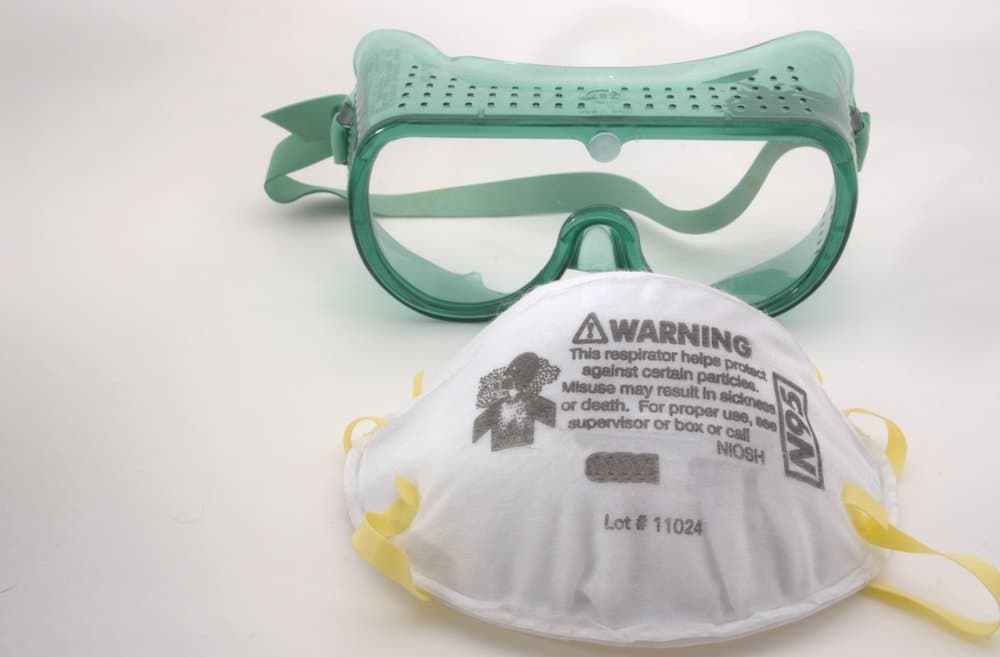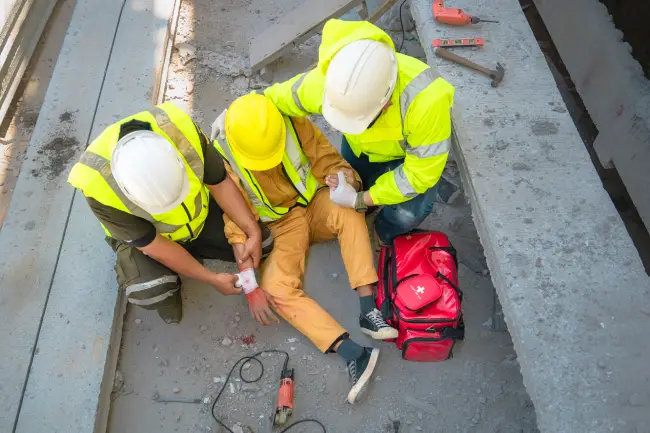OSHA Inspection Q & A With Industry Expert Rick Foote
 In case you missed it, Triumvirate recently hosted an OSHA Inspection Preparation webinar with industry expert, Rick Foote. Here are all the questions asked in the live Q&A and their answers. The questions that weren't addressed during the live Q&A are also answered here.
In case you missed it, Triumvirate recently hosted an OSHA Inspection Preparation webinar with industry expert, Rick Foote. Here are all the questions asked in the live Q&A and their answers. The questions that weren't addressed during the live Q&A are also answered here.
1. Is there a list of potential written plans that we should have?
OSHA does not have a specific list of required plans. In order to determine which plans you need to have you first have to determine which regulations are applicable to your facility. Once you have determined the applicability, you can then make the determination on what information you are required to have to document compliance.
2. If we are signatory with a union, do we have to have the union reps present at the opening conference?
OSHA has a Letter of Interpretation on who should be present during the actual site review. The Letter of Interpretation can be found here. OSHA does not specific state that a Union Representative needs to be present at the opening conference but many legal consultants always state that this is a good idea. The Opening Conference should be used to both highlight how good your program is and that all employees are participants and also to better understand what the site review will entail. Sharing this information with the Union Representative can only help show them that you are not “hiding” anything from them also.
3. Recommendations on how to convince management of the need to better prepare?
The best manner that I can state on this is to detail out for them the value of a compliant OSHA program. This includes the cost of an injury to the company. The current rate is estimated to be $38,000 per injury according to the National Safety Council. This cost includes emergency room and doctor visits, medical bills, medicines, and rehabilitation. Secondly, most insurance companies will take into consideration if you can lower your overall injury rates. This will include the workers compensation cost which we all know are extremely high. Additionally, if you were to become involved in any of the OSHA Voluntary Compliance Programs (SHARP or VPP), this will also help lower insurance cost. Lastly, and most important is if employees feel that management cares about their safety and well-being this will help with morale and should turn into better production from employees.
4. Have you heard of OSHA issuing a citation for a company not meeting the new voluntary PEL's for hazardous chemicals?
I have not heard of any such occurrences. However, OSHA is looking for help on changing the PEL’s in the future. OSHA released on October 9, 2014 a Request for Information (RFI) on Chemical Management and Permissible Exposure Limits (PELs) in the Federal Register. This is a new approach to hopefully updating and changing the current program. Any specific OSHA requirements for a small business? The Occupational Safety Act covers almost all businesses. The exceptions are few such as self-employed workers, immediate family members of farm employers, and workers whose hazards are regulated by another federal agency (for example, the Mine Safety and Health Administration, the Department of Energy, or Coast Guard).
5. How many inspections in state universities?
OSHA publishes all of the inspections that they have conducted each year. The list can be searched either by Standard Industrial Classification Code (SIC code) or by name. Using the SIC code of 8221, there were approximately 194 inspections conducted at Colleges and Universities.
6. Can you repeat the name of the company that helps small businesses with OSHA compliance?
Most states have an OSHA Consultation Service that will assist a small business with compliance. They can conduct site reviews and give you guidance on written programs and training resources also.
7. Are we responsible for ensuring that a company who leases space in our building is OSHA compliant?
The OSHA regulations state that the employer is responsible to keep all of its employees safe. If you are the landlord then no, you are not responsible for what your tenants do. However, it is important to review the wording on the lease agreement to ensure that this does not state otherwise. Also, if there are any physical issues (signage, lighting etc) this may be your responsibility.
8. What about the nuclear plants. Does OSHA have jurisdiction over them?
Yes, OSHA does have some jurisdiction over Nuclear facilities. According, to a Nuclear Regulatory Commission Inspection Manual, they state the following areas are covered by OSHA: “Plant conditions that result in an occupational risk, but do not affect the safety of licensed radioactive materials. For example, there might be exposure to toxic non-radioactive materials and other industrial hazards in the workplace.”
9. Can OSHA conclude with a closing conference, then contact us again to hold another one?
Typically, the closing conference is to close out the audit. I have not heard of any instances of a second closing conference meetings be held. I have heard of OSHA requesting further information or time to clarify something that they have seen but typically this is covered either by phone or through the mail.
10. If you have multiple locations, should a committee and facilitator be present at every site or is one committee with the ability to travel between sites sufficient?
The answer to this would be dependent upon the distance between each location. If the locations are relatively close to each other then it may be acceptable. Please keep in mind that when OSHA arrives onsite they expect to be assisted within a reasonable amount of time. I cannot state what that time is since that is a question that each location will need to answer themselves. My experience has been that it is best to have at least one representative at each location that can at least start the process until others can arrive to assist.
11. I used to like to use actual citation in backup for "selling" to management the need to make changes... is that information still public information?
Yes, OSHA publishes all enforcement actions that occur during the year. Each citation and the amount is available on the OSHA website. Here is the link to this information: https://www.osha.gov/dep/index.html
12. You said there were no exceptions- but aren't there certain SIC groups that are not included- such as R&D or Engineering?
We had an OSHA inspector leave based on SIC code. The Occupational Safety Act covers almost all businesses. The exceptions are few such as self-employed workers, immediate family members of farm employers, and workers whose hazards are regulated by another federal agency (for example, the Mine Safety and Health Administration, the Department of Energy, or Coast Guard). I would also like to add that there are some regulations that have relaxed requirements (Recordkeeping) for some SIC codes but the OSHA regulations are still applicable in most cases.
13. You said to monitor employee interviews, but in my experience the OSHA Inspector made us leave the room during the employee interview, can we insist on staying?
Employee interviews are common during the audit process. Here are some of the rights that employees have during this process: * Has a right to a private one-on-one interview with the compliance officer which is confidential and is considered “protected activity.” The employee cannot suffer any “adverse action” from the employer for exercising this right. The compliance officer cannot disclose the contents of the interview. * Has a right to refuse to be interviewed by the compliance officer. In other words, an employee cannot be forced to have a private one-on-one interview. These interviews are totally voluntary. If the employee declines to be interviewed (and the employee need not give any reason for the decision) the agency will have to obtain a subpoena to require the interview. If the agency obtains a subpoena, the employee has the full scope of rights to respond, including the right to counsel. * Has a right to decline to have a one-on-one private interview and the right to have a person of their choice attend the interview and, if the compliance officer refuses to allow this person to attend, decline to be interviewed. Some employees feel comfortable being interviewed if they have another person present during the interview. Again, if the compliance officer refuses to allow this other person to attend, the employee can decline the interview for no reason. * Has a right to end the interview at any time for any reason. Since the interview is completely voluntary (unless OSHA subpoenaed the employee) the employee can end the interview at any time and can leave without any explanation. * Has a right to refuse to sign a statement, be tape recorded or photographed. * Has the right to refuse to provide any private contact information, such as home address and telephone number. * Has the right to require the interview to occur at the workplace.
14. Are OSHA audits unannounced?
OSHA Inspections are conducted for many reasons. Most of the audits are unannounced and must be according to the regulations. There are a few exceptions to this, they are as follows: Advance notice of inspections may not be given (29 CFR 1903.6), except in the following situations: * In cases of apparent imminent danger, to enable the employer to abate the danger as quickly as possible * In circumstances where the inspection can most effectively be conducted after regular business hours or where special preparations are necessary for an inspection; * Where necessary to assure the presence of representatives of the employer and employees or the appropriate personnel needed to aid in the inspection; and * In other circumstances where the Area Director determines that the giving of advance notice would enhance the probability of an effective and thorough inspection.
15. Can quality OSHA compliance lower company insurance rates?
Some insurance companies do over discounts on worker compensation if a facility has a good compliance program or they obtain either OSHA SHARP status or are part of the Voluntary Protection Program. Each company will need to check with their own insurance carrier to determine if they offer any discounts.
16. We perform work in both construction and general industry, how do I know when we are in construction or general industry?
For example, fall protection. What does OSHA look at to determine which standard applies? OSHA defines construction work in 1910.12 (b) as follows: "For purposes of this section, Construction work means work for construction, alteration, and/or repair, including painting and decorating…" If your employees are conducting any of these types of activities then you are doing Construction related activities and OSHA will review the regulations as such. If your employees are using fall protection to paint the side of the building, then yes this would be considered a construction activity.
17. Does OSHA have authority to investigate a complaint from a government entity?
The OSHA regulations are applicable as follows: State and Local Government Workers Employees who work for state and local governments are not covered by Federal OSHA, but have OSH Act protections if they work in a state that has an OSHA-approved state program. Four additional states and one U.S. territory have OSHA approved plans that cover public sector employees only. This includes: Connecticut, Illinois, New Jersey, New York, and the Virgin Islands. Private sector workers in these four states and the Virgin Islands are covered by Federal OSHA. Federal Government Workers Federal agencies must have a safety and health program that meet the same standards as private employers. Although OSHA does not fine federal agencies, it does monitor federal agencies and responds to workers' complaints. The United States Postal Service (USPS) is covered by OSHA. Not covered by the OSH Act: Self-employed; Immediate family members of farm employers that do not employ outside employees; and Workplace Hazards regulated by another Federal agency (for example, the Mine Safety and Health Administration, the Federal Aviation Administration, the Coast Guard). Source: https://www.osha.gov/workers.html
18. Are small organizations also audited regularly?
OSHA publishes all of the inspections that they have conducted each year. The list can be searched either by Standard Industrial Classification Code (SIC code) or by name. In order to determine the amount of inspection in your SIC Code, I would recommend that you review the website.
19. Do you have any words of wisdom in regards to contractor safety policies and OSHA compliance?
The OSHA regulations do not specifically state that you need to have a Contractor Safety Program. However, it is implied in some standards that you share with a contractor all information that is known to exist at the facility. In the same manner, in order to protect your employees you need to ensure that the contractor is abiding by your policies and programs also so therefore you will need to ensure that they are compliant. I highly recommend that you create a written Contractor Safety Plan that details all of the requirements that they need to follow. This will allow you to request copies of their programs and trainings to ensure they are compliant also.
20. Does the union representative have to be invited to the opening conference? When they invite themselves, can we ask them to leave?
The OSHA Inspection protocols state that they want representation from both the Employer and Employees when conducting an inspection. The law says that a representative authorized by workers has a right to accompany the inspection. This applies whether you requested an inspection or to an OSHA scheduled inspection. Under no circumstances may the employer choose the workers' representative. I would think that asking them to leave is a good idea since you may be in violation of the regulations regarding representation.
21. After how many years will a company no longer be cited with a repeat violation from a past citation when an old violation is repeated?
The typical time span is within 5 years of the last violation. There have been some court challenges to this requirement.
22. When we did get fined/cited by OSHA, what's the best way to go about fighting it?
The best manner in order to “fight” an OSHA violation is to request an “Informal Conference”. During this time you can: * Obtain a better explanation of the violations cited; * Obtain a more complete understanding of the specific standards that apply; * Negotiate and enter into an informal settlement agreement; * Discuss ways to correct violations; * Discuss issues concerning proposed penalties; * Discuss proposed abatement dates; * Resolve disputed citations and penalties, (thereby eliminating the need for themore formal procedures associated with litigation before the Occupational Safety and Health Review Commission); and * Obtain answers to any other questions you may have.
23. I've heard that there are new changes to OSHA's record keeping rule; are there any changes I need to make to my record keeping practices?
Yes, OSHA has revised this rule. Employers are now required to notify OSHA of work-related fatalities within eight hours, and work-related in-patient hospitalizations, amputations or losses of an eye within 24 hours. Previously, OSHA's regulations required an employer to report only work-related fatalities and in-patient hospitalizations of three or more employees. Reporting single hospitalizations, amputations or loss of an eye was not required under the previous rule. All employers covered by the Occupational Safety and Health Act,(certain SIC Codes) even those who are exempt from maintaining injury and illness records, are required to comply with OSHA's new severe injury and illness reporting requirements.
24. A big topic at my institution lately has been the Ebola virus. What are worker rights recording to OSHA?
The OSHA regulations require that all work sites are free of all known hazards. Therefore, if the facility has any reason to suspect that the virus may be present, they are required to take action and to determine what regulations may be applicable. OSHA has also developed a webpage that contains links to the Center for Disease Control website and links to several current regulations. The regulations include the Blood borne Pathogens, Personal Protective Equipment, Respiratory Protection and sanitation are regulations that could possibly be applicable to a workplace that this virus may be present in. The CDC is the leading government agency regarding this virus.
For more information on how we can help you stay compliant, check out our OSHA compliance review services in the link below.






